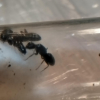- Formiculture.com
- Forums
- Gallery
- Members
- Member Map
- Chat

Formica. Michigan
Started By
AntJohnny
, Mar 29 2019 1:45 PM
10 replies to this topic
#1
 Offline
-
Posted March 29 2019 - 1:45 PM
Offline
-
Posted March 29 2019 - 1:45 PM
I found three of these queens in the soil, under a rock in my front yard. They are about 1 cm. Shiny black and no hairs on there gaster.
#3
 Offline
-
Posted March 29 2019 - 1:47 PM
Offline
-
Posted March 29 2019 - 1:47 PM
Sorry I didn't realize the pictures didn't go through. I'll put them on somewhere else
#4
 Offline
-
Posted March 29 2019 - 1:47 PM
Offline
-
Posted March 29 2019 - 1:47 PM
Gonna need pics! If they are Formica, they would most likely be F. subsericea.
My Main Journal | My Neivamyrmex Journal | My Ant Adoption | My YouTube
Join the TennesseeAnts Discord Server! https://discord.gg/JbKwPgs
#5
 Offline
-
Posted March 29 2019 - 1:56 PM
Offline
-
Posted March 29 2019 - 1:56 PM
http://imgur.com/gallery/CSwwjIQ
I had to put the photos on imgur. Let me know if you guys are able to see them that way. I didn't mean the put the lasious picture in there. I'm pretty sure that one is a umbratus or claviger though.
I had to put the photos on imgur. Let me know if you guys are able to see them that way. I didn't mean the put the lasious picture in there. I'm pretty sure that one is a umbratus or claviger though.
Edited by AntJohnny, March 29 2019 - 1:57 PM.
#6
 Offline
-
Posted March 29 2019 - 2:10 PM
Offline
-
Posted March 29 2019 - 2:10 PM
If they are subsericea. Will the queens fight if they are together? I have two in a antcanada 4 way adapter with two testubes. They haven't left there own test tube yet. And 1 queen by herself. I want a multi queen colony if I'm able to house them together.
#7
 Offline
-
Posted March 29 2019 - 2:53 PM
Offline
-
Posted March 29 2019 - 2:53 PM
2 are formica, last ones a parasitic lasius. first could also be a normal lasius. formica are single queened.
seperate your two queens.
#8
 Offline
-
Posted March 29 2019 - 3:34 PM
Offline
-
Posted March 29 2019 - 3:34 PM
You have to post ID requests following the ID format. It isn't hard to look before you post; it's the top pinned topic for the ID Request thread.
- AntsBC likes this
#9
 Offline
-
Posted March 29 2019 - 3:38 PM
Offline
-
Posted March 29 2019 - 3:38 PM
Ok thank you for the help.
#10
 Offline
-
Posted March 29 2019 - 7:05 PM
Offline
-
Posted March 29 2019 - 7:05 PM
2 are formica, last ones a parasitic lasius. first could also be a normal lasius. formica are single queened.
seperate your two queens.
Atually many Formica are polygynous, like Formica fusca, rufa, obscuripes.
My Main Journal | My Neivamyrmex Journal | My Ant Adoption | My YouTube
Join the TennesseeAnts Discord Server! https://discord.gg/JbKwPgs
#11
 Offline
-
Posted April 6 2019 - 10:35 AM
Offline
-
Posted April 6 2019 - 10:35 AM
2 are formica, last ones a parasitic lasius. first could also be a normal lasius. formica are single queened.
seperate your two queens.
Atually many Formica are polygynous, like Formica fusca, rufa, obscuripes.
I didn't know that. all the formica around here seem to be single gyned.
0 user(s) are reading this topic
0 members, 0 guests, 0 anonymous users


















